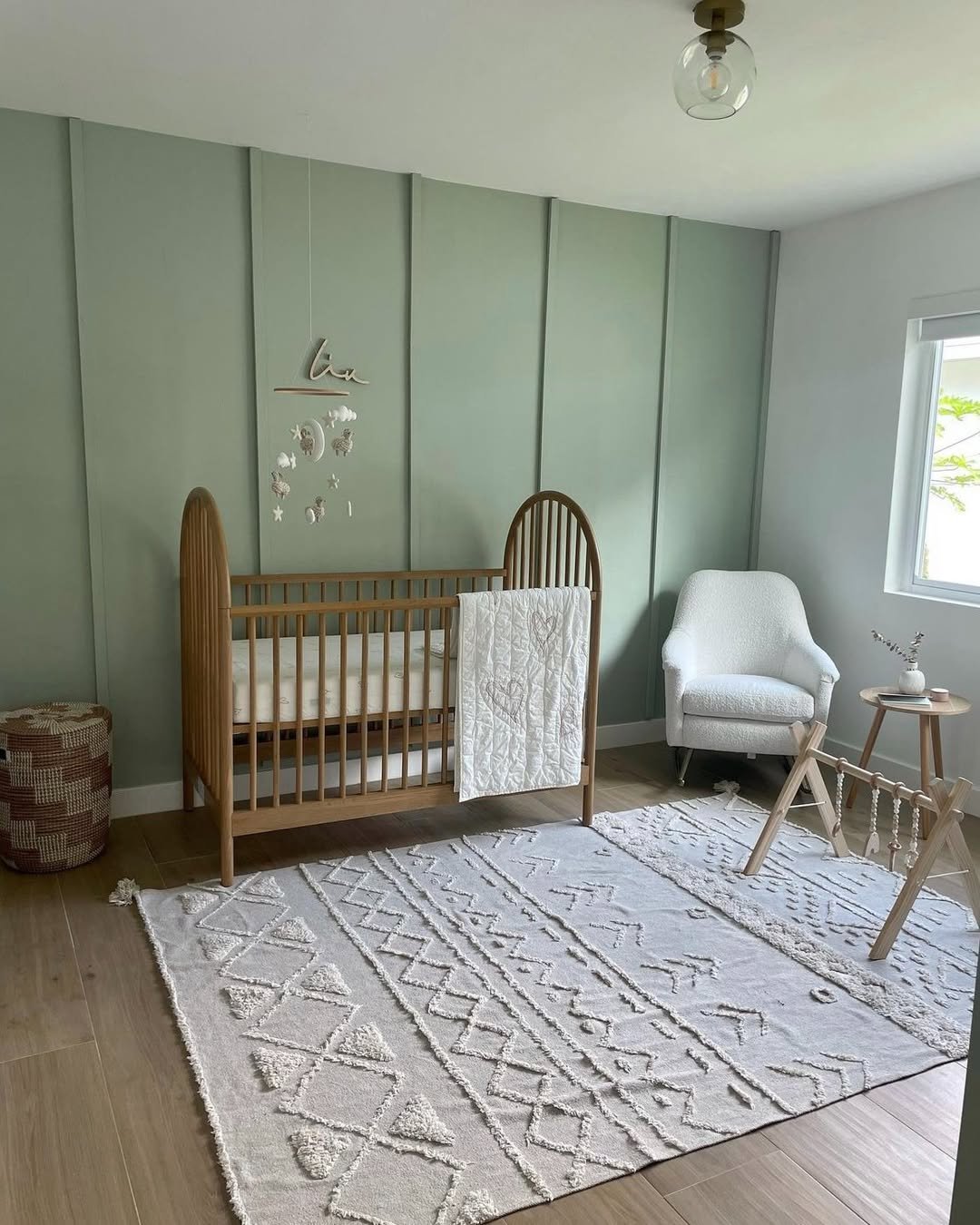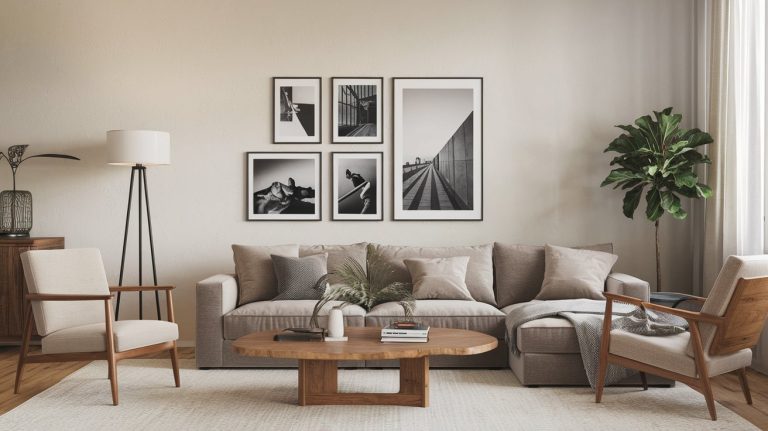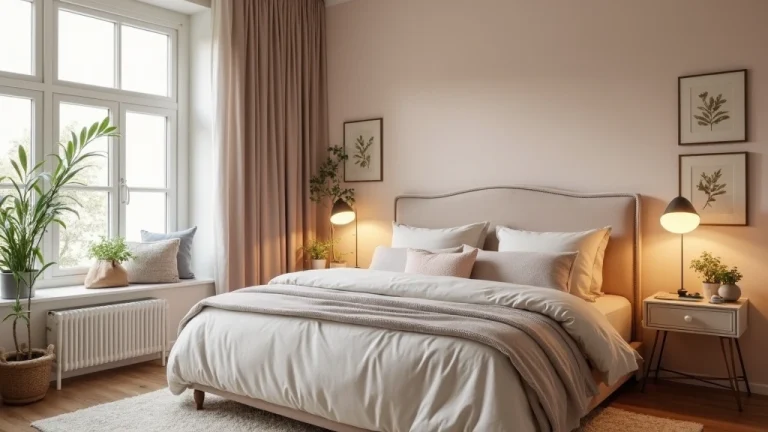
Designing your nursery is one of the most exciting parts of preparing for parenthood. It’s a space where you’ll spend countless hours nurturing, bonding, and watching your little one grow.
You can pick from the warmth of natural wood elements to the serenity of textured white walls. We have 20 neutral nursery ideas that offer endless possibilities for creating a timeless space. Combine earth tones with geometric patterns, mix in botanical touches, and layer different textures.
The beauty of neutral nursery design lies in its versatility and longevity. Want to learn more about different nursery ideas in detail? Let’s get started!
20 Neutral Nursery Ideas
Looking to design a nursery that grows with your child and stands the test of time? These gender-neutral nursery ideas combine practicality with style, creating spaces that are both beautiful and functional.
1. Natural Wood Elements
The warmth of natural wood brings an organic, calming presence to any nursery.

Consider incorporating wooden furniture pieces like a raw pine crib, unfinished oak dresser, or bamboo rocking chair. These pieces add texture and character while maintaining a neutral palette that works with any design scheme.
The beauty of natural wood elements lies in their versatility. As your child grows, these pieces can be easily repurposed or refinished to match evolving tastes. Plus, the durability of quality wooden furniture ensures these investments will last through multiple children or even generations.
2. Textured White Walls

White doesn’t have to mean boring. Add dimension to your nursery walls with textured wallpaper, board and batten details, or a subtle grasscloth covering. These elements create visual interest while maintaining a clean, bright atmosphere that makes a space feel larger and more welcoming.
The key to making white walls work is layering different shades and textures.
Combine smooth painted surfaces with tactile elements like woven wall hangings or three-dimensional wall art. This approach creates depth and interest without introducing competing colors that might overwhelm the space.
3. Earth Tone Color Palette
Embrace the soothing qualities of nature-inspired colors like warm beige, soft taupe, and gentle gray.
These earth tones create a grounding environment that feels both sophisticated and nurturing. Start with a base of lighter neutrals and layer in deeper shades through furniture and accessories.
The beauty of an earth tone palette lies in its adaptability. These colors work seamlessly with modern and traditional design elements, allowing you to update the room’s style as your child grows.
Consider incorporating different textures in similar tones to add depth without disrupting the calming atmosphere.
4. Geometric Patterns
Modern nurseries come alive with the addition of geometric patterns that add visual interest while maintaining neutrality. Think hexagon wall decals, triangle-print bedding, or circular area rugs.
These patterns create movement and energy without overwhelming the space or leaning toward any particular gender.
The key to using geometric patterns successfully is maintaining a consistent scale and limiting your pattern choices to two or three complementary designs.
This prevents the room from feeling too busy while still providing the visual stimulation that benefits your baby’s developing mind.
5. Botanical Touches
Bring the outside in with subtle botanical elements that add life to your neutral nursery. Consider pressed leaf artwork, plant-themed wall decals, or even carefully selected artificial plants placed out of reach. These natural elements create a connection to the outdoors while maintaining a sophisticated aesthetic.
The trick to incorporating botanical elements is choosing varieties with neutral tones and simple shapes. Avoid overly colorful or busy prints in favor of monochromatic leaf patterns or simple branch designs.
This approach maintains a calm atmosphere while adding organic visual interest.
6. Mixed Metals
Incorporate different metal finishes to add subtle glamour to your neutral nursery. Combine brushed brass light fixtures with chrome drawer pulls, or mix matte black picture frames with silver mirror accents. The key is to choose finishes that complement rather than compete with each other.
Keep the metal elements balanced throughout the room rather than concentrated in one area. This creates a cohesive look that feels intentional rather than haphazard.
Consider using metals in both functional items like lamps and decorative pieces like wall art.
7. Textural Layering
Create depth and interest through the thoughtful layering of different textures. Combine smooth cotton bedding with chunky knit blankets, plush rugs with woven baskets, and velvet pillows with linen curtains.
This approach adds richness to the neutral palette while creating a cozy, inviting atmosphere.
Focus on varying the scale and density of textures to create visual contrast. Mix larger, chunkier textures with finer, more delicate ones to create a balanced look.
This variety not only looks beautiful but also provides sensory stimulation for your developing baby.
8. Animal Motifs
Incorporate subtle animal designs that maintain sophistication while adding whimsy. Think abstract line drawings of animals, simple silhouettes, or gentle watercolor prints in neutral tones.
These elements add personality without overwhelming the space or limiting future design changes.
Choose animal motifs that can grow with your child, avoiding overly cartoonish or babyish designs. Consider using these elements in easily changeable items like artwork or throw pillows. It allows you to update the room’s theme as your child’s interests evolve.
9. Cloud and Star Theme
Create a dreamy atmosphere with subtle celestial elements. Incorporate cloud-shaped pillows, star wall decals in metallic neutrals, or constellation artwork.
This theme works beautifully in a neutral palette while sparking imagination and creating a peaceful environment.
Balance the whimsical elements with more grounded pieces to maintain sophistication. Consider using different shades of white and gray to create depth, and add metallic accents sparingly for a touch of magic without overwhelming the space.
10. Scandinavian Simplicity
Embrace the clean lines and minimalist approach of Scandinavian design. Focus on functional furniture with simple silhouettes, light wood tones, and plenty of white space. This style naturally lends itself to a neutral palette while creating a calm, organized environment.
Incorporate cozy elements like sheepskin rugs or chunky knit throws to soften the minimal aesthetic. Keep decoration simple but meaningful, choosing a few high-quality pieces that serve both functional and aesthetic purposes.
11. Woven Elements
Integrate natural fiber elements like rattan, jute, and seagrass throughout the space. Consider a woven pendant light, storage baskets, or even a statement wall piece. These materials add warmth and texture while maintaining a neutral color scheme.
The key to using woven elements effectively is varying the scale and weave patterns. Mix tighter weaves with more open designs, and combine different natural materials to create visual interest while maintaining a cohesive look.
12. Abstract Art
Incorporate large-scale abstract art pieces that add visual interest while maintaining neutrality. Look for pieces with gentle sweeping lines, subtle color variations, or interesting textural elements.
These pieces can serve as focal points while contributing to the room’s calm atmosphere.
Choose art that can grow with your child rather than typical nursery pieces. Consider creating a gallery wall with a mix of abstract pieces in different sizes and styles, all within your chosen neutral palette.
13. Letter and Number Graphics
Add educational elements through sophisticated typography and number designs. Use oversized wooden letters, metal numerals, or graphic prints featuring alphabets or counting themes.
Keep these elements neutral in color while making them visually interesting through size and placement.
Consider how these educational elements can be integrated naturally into the design rather than feeling forced. Mix them with other decorative elements to create a balanced look that’s both functional and beautiful.
14. Natural Light Emphasis
Design your nursery to maximize natural light while maintaining privacy and sleep functionality. Use light-filtering window treatments in layers, combining sheer curtains with blackout blinds.
Choose window coverings in neutral tones that complement your overall color scheme.
Consider the placement of furniture to take advantage of natural light during daytime hours while creating cozy corners for feeding and quiet time. Use mirrors strategically to reflect light and make the space feel larger.
15. Subtle Stripes
Incorporate classic stripe patterns in varying scales and neutral tones. Consider wide horizontal stripes on an accent wall, pinstriped bedding, or striped storage containers. This timeless pattern adds visual interest while maintaining sophistication.
Mix different stripe widths and orientations to create depth and movement in the space. Keep the color contrast subtle to maintain a calm atmosphere while still adding visual texture to the room.
16. Cozy Reading Nook
Create a dedicated reading area with a comfortable chair, good lighting, and accessible book storage. Choose furniture in neutral tones and add texture through pillows and throws. This space should feel inviting and peaceful for both parent and child.
Incorporate practical elements like a side table for drinks and a floor lamp for evening reading. Consider using floating shelves to display books face-forward, creating both storage and wall decoration.
17. Organized Open Storage
Design storage solutions that are both functional and aesthetically pleasing. Use open shelving to display carefully curated items, mixing practical storage with decorative elements. Choose containers and baskets in coordinating neutral tones.
Create visual interest through the arrangement of items, varying heights and textures while maintaining a cohesive color scheme. Include both closed storage for clutter and open displays for frequently used items and decorative pieces.
18. Quilted Textures
Incorporate quilted elements for both visual interest and comfort. Consider a quilted wall hanging, bedding, or play mat in neutral tones. These pieces add sophisticated texture while providing practical comfort for your baby.
Mix different quilting patterns and scales while keeping colors neutral. This creates depth and interest while maintaining the calm atmosphere essential for a nursery space.
19. Natural Fiber Lighting
Choose lighting fixtures made from natural materials like linen, cotton, or paper. Consider a large drum shade pendant, woven table lamps, or even paper lanterns. These elements add soft, diffused light while contributing to the neutral palette.
Layer different types of lighting to create flexibility for various times of day and activities. Include task lighting for diaper changes, ambient lighting for playtime, and soft options for bedtime routines.
20. Mindful Color Blocking
Create visual interest through subtle color blocking using different neutral shades. Consider painting geometric shapes on walls, using two-tone furniture, or incorporating color-blocked textiles. This adds sophistication while maintaining the neutral theme.
Keep the contrast between colors subtle to maintain a peaceful atmosphere. Use this technique sparingly to create focal points without overwhelming the space.
Recommended Reads:
Conclusion
Creating a neutral nursery is about more than just choosing the right colors. It’s about crafting a harmonious environment that promotes both comfort and development. Whether you prefer Scandinavian simplicity or love incorporating natural textures, these ideas provide a solid foundation for designing a space.
The key to a successful neutral nursery lies in balancing practical functionality with thoughtful design elements. It’s gonna ensure a peaceful, nurturing atmosphere for both parent and child.





